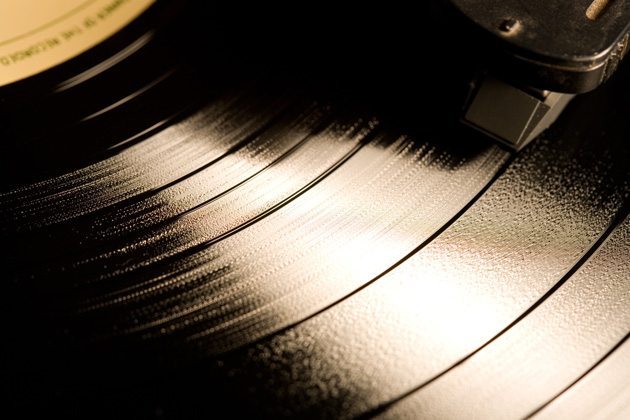…….great article from the Feedbands website that gets right into the nitty-gritty of exactly what makes vinyl err vinyl….
The vinyl record is a type of gramophone record, most popular from the 1950s to the 1990s, that was most commonly used for mass-produced recordings of music.
A vinyl gramophone or phonograph record consists of a disc of polyvinyl chloride plastic, engraved on both sides with a single concentric spiral groove in which a sapphire or diamond needle, stylus, is intended to run, from the outside edge towards the centre (though it should be noted that on a very small number of albums, like “Goodbye Blue and White” by Less Than Jake, a hidden track, or the entire side, will be played from the centre out).
While a 78 rpm record is brittle and relatively easily broken, both the microgroove LP 33⅓ rpm record and the 45 rpm single records are made from vinyl plastic which is flexible and unbreakable in normal use. 78s come in a variety of sizes, the most common being 10 inch (25 cm) and 12 inch (30 cm) diameter, and these were originally sold in either paper or card covers, generally with a circular cutout allowing the record label to be seen. The Long-Playing records (LPs) usually come in a paper sleeve within a colour printed card jacket which also provides a track listing. 45 rpm singles and EPs (Extended Play) are of 7 inch (17.5 cm) diameter, the earlier copies being sold in paper covers. Grooves on a 78 rpm are much coarser than the LP and 45.
Common formats
- 12″ (30 cm) 33⅓ rpm long-playing (LP) format
- 7″ (17.5 cm) 45 rpm (single) format
Less common formats
- 12″ (30 cm) 45 rpm extended-playing 12-inch (30 cm) single, Maxi Single and EP format
- 10″ (25 cm) 33⅓ rpm long-playing (LP) format
- 10″ (25 cm) 45 rpm extended-playing (EP) format
- 7″ (17.5 cm) 33⅓ rpm extended-playing (EP) format
- 16⅔ rpm format for voice recording
- 12″ (30 cm), 10″ (25 cm) and 7″ (17.5 cm) picture discs and shaped discs
- Specialty sizes (5″ (12 cm), 6″ (15 cm), 8″ (20 cm), 9″ (23 cm), 11″ 28 cm), 13″ (33 cm))
- Flexidiscs, often square 7″s (17.5 cm)
Vinyl record standards for the United States follow the guidelines [1] of the RIAA (the Record Industry Association of America). The inch dimensions are not actual record diameters, but a trade name. The actual dimension of a 12 inch record is 302 mm (11.89 in), for a 10 inch it is 250 mm (9.84 in), and for a 7 inch it is 175 mm (6.89 in).
Records made in other countries follow different guidelines. The record diameters are commonly 30 cm, 25 cm and 17.5 cm in most countries. See: http://www.gzcd.cz/en/doc/tc-vinyl.pdf
History and development
In 1930, RCA Victor launched the first commercially-available vinyl long-playing record, marketed as “Program Transcription” discs. These revolutionary discs were designed for playback at 33⅓ rpm and pressed on a 12″ diameter flexible plastic disc. In Roland Gelatt’s book The Fabulous Phonograph, the author notes that RCA Victor’s early introduction of a long-play disc was a commercial failure for several reasons including the lack of affordable, reliable consumer playback equipment and consumer wariness during the Great Depression. A good outline of this unsuccessful product launch can be found at the following site.
However, vinyl’s lower playback noise level than shellac was not forgotten. During and after World War II when shellac supplies were extremely limited, some 78 rpm records were pressed in vinyl instead of shellac (wax), particularly the six-minute 12″ (30 cm) 78 rpm records produced by V-Disc for distribution to US troops in World War II.
Beginning in 1939, Columbia Records continued development of this technology. Dr. Peter Goldmark and his staff undertook exhaustive efforts to address problems of recording and playing back narrow grooves and developing an inexpensive, reliable consumer playback system. In 1948, the 12″ (30 cm) Long Play (LP) 33⅓ rpm microgroove record was introduced by the Columbia Record at a dramatic New York press conference.
The commercial rivalry between RCA Victor and Columbia Records led to RCA Victor’s introduction of what it had intended to be a competing vinyl format, the 7″ (17.5 cm) / 45 rpm Extended Play (EP). For a two-year period from 1948 to 1950, record companies and consumers faced uncertainty over which of these formats would ultimately prevail in what was known as the “War of the Speeds”.
Eventually, the 12″ (30 cm) / 33⅓ rpm LP prevailed as the predominant format for musical albums, and the 7″ (17.5 cm) / 45 rpm EP or “single” established a significant niche for shorter duration discs typically containing one song on each side. The EP discs typically emulated the playing time of the former 78 rpm discs, while the LP discs provided up to one-half hour of time per side.
After the introduction of high-quality but expensive stereo reel-to-reel tapes in 1955 and the increasing public fascination with stereo sound, intense work was undertaken to devise a scheme for recording stereo sound on 12″ (30 cm) / 33⅓ rpm LP. In late 1957, a system of cutting and playing back stereo was devised and generally accepted by the industry. Consumer acceptance of stereo LPs was somewhat cautious initially but grew steadily during the early 1960s, and the industry largely discontinued production of conventional monaural LP records and playback equipment by 1968.
Similarly, the introduction of high-quality but expensive quadraphonic (four channel) reel-to-reel tapes and 8-track tape cartridges in 1970 led to the introduction of quadraphonic vinyl records, which arrived on the market in 1972. Although public interest was initially high, the lack of compatibility between the three competing SQ, QS, and CD-4 formats prompted the eventual commercial failure of quadraphonic LP
records. Most record companies stopped producing quadraphonic LPs after 1975 although a handful of classical-music titles continued to be issued until 1980.
Other major developments worth noting:
During the early 1970s, a cost-cutting move towards use of lighweight, flexible vinyl pressings. Marketed by RCA Victor as the Dynaflex process, much of the industry adopted a technique of reducing the thickness and quality of vinyl used in mass-market manufacturing. In many cases, this included using “regrind” vinyl as a means of cutting manufacturing costs.
During the late 1970s, an audiophile-focused niche market for “direct-to-disc” records, which completely bypassed use of magnetic tape in favor of a “purist” transcription directly to the master lacquer disc.
During the early 1980s, an audiophile-focused niche market for “DBX-encoded” records, which were completely non-compatible with standard record playback preamplifiers, relying on a sophisticated DBX noise reduction encoding/decoding scheme to virtually eliminate playback noise and increase dynamic range. A similar and very short-lived scheme involved using the CBS-developed “CX” noise reduction encoding/decoding scheme.
During the late 1970s, an audiophile-focused niche market for “half-speed mastered” and “original master” records, using expensive state-of-the-art technology.
During the late 1970s and 1980s, the use of highly advanced disc cutting equipment to improve the dynamic range and reduce inner-groove distortion of mass-produced records, using techniques marketed as the CBS Discomputer and Teldec Direct Metal Mastering.
Although replaced by digital media such as the compact disc as a mass market music medium, vinyl records continue to be manufactured and sold in the 21st century.
Historically the most common formats are:
- 12″ (30 cm) / 33⅓ rpm LP
- 7″ (17.5 cm) / 45 rpm EP or Single
followed by
- 10″ (25 cm)/ 45 rpm LP (superceeded by 12″ (30 cm) / 33⅓ rpm LP in the 60’s)
- 12″ (30 cm) / 33 or 45 rpm Maxi Single (introduced in the 80’s)
Today most of the records are issued in 12″ (30 cm) LP or Maxi Single.
The sound quality and durability of vinyl records is highly dependent on the quality of the vinyl used. Most vinyl records are pressed on recycled vinyl. New “virgin” or “heavy” (180-220 gram) is commonly used for classical music, although it has been used for some other genres. Today, it is increasingly common in vinyl pressings that
can be found in most record shops. Even modern albums like Shellac’s and Mission of Burma’s latest are pressed on 180 g/m² vinyl, though most are reissues of classic albums, like The Clash’s series of reissues. These albums tend to withstand the deformation caused by normal play better than regular vinyl.
While most vinyl records are pressed from metal master discs, a technique known as lathe-cutting was introduced in the late 1980s by Peter King of Geraldine, New Zealand. A lathe is used to cut microgrooves into a clear polycarbonate disc. Lathe cut records can be made inexpensively in small runs. However, the sound quality is significantly worse than proper vinyl records, and lathe cut records tend to degrade further in quality after repeated playing.
Vinyl vs. compact discs
In the early days of compact discs, vinyl records were still prized by audiophiles because of better reproduction of analog recordings, however the drawback was greater sensitivity to scratches and dust. Early compact discs were perceived by some as screechy, distorting sounds on the high end, and not as “warm” as vinyl especially in recordings that require a wide dynamic range (eg. classical recordings). This resulted in a slower acceptance of digital music in its early years by some listeners.
Though digital audio technology has improved over the years, some audiophiles still prefer what they perceive as the warmer and more detailed sound of vinyl over the harsher sound of CDs. Some listeners were also disappointed by what they considered to be unfaithful remastering of analog recordings. The advent of higher-quality digital formats, notably SACD, offers the tantalizing possibility of combining the high-quality sound of the best analog recordings with the convenience and durability of the CD. Many artists still release recordings, in limited pressings, on vinyl.
For DJs, mostly in the electronic dance music or hip hop genres, vinyl has another advantage over the CD: the direct manipulation of the medium. While with CDs or cassettes one normally has only indirect manipulation options (the play/stop/pause etc. buttons), with a record one can put the needle a few tracks farther in- or outwards and accelerate/decelerate the spinning or even reverse the direction (if the needle and record player is built to withstand it). However some professional CD players now have this capability.
One company has developed a player that uses a laser instead of a needle to read vinyl discs. In theory, it eliminates the possibility of scratches and attendent degradation of the sound, but its expense limits use primarily to digital archiving of analog records.
Looking for vinyl records? Be sure to check eil.com for an incredible range of rarities, reissues, audiophile pressings, imports and more, for full list click here





Be the first to comment